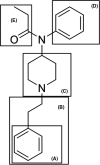Fentanyl-related substance scheduling as an effective drug control strategy
- PMID: 33951192
- PMCID: PMC8360110
- DOI: 10.1111/1556-4029.14712
Fentanyl-related substance scheduling as an effective drug control strategy
Abstract
Fentanyl is now the primary driver of the current opioid crisis. Fentanyl and its analogues are subject to the Controlled Substances Act of 1970, the Controlled Substances Analogue Enforcement Act of 1986 (Federal Analogue Act), state laws, international treaties, and the laws of foreign countries. The appearance of novel psychoactive substances led to further legislative developments in scheduling. New fentanyl analogues proliferated in a manner previously unseen since about 2016. Overdose deaths of these fentanyl analogues prompted the Drug Enforcement Administration to reactively emergency schedule each new fentanyl analogue as it appeared. The international community also acted. Finally, on February 6, 2018, a proactive temporary (emergency) class-wide scheduling of fentanyl-related substances was implemented based upon the fentanyl core structure to save lives. This action spurred a similar action in China. Fentanyl analogues fell dramatically in the marketplace, despite further increases in fentanyl itself. Congress temporarily extended this scheduling, but it will soon expire. Opposition to permanent class-wide was lodged due to concerns over law enforcement overreach, inadequate Health and Human Services input, and hindrance of research. This paper reaffirms the importance of a class-based scheduling strategy while also arguing for increased research of schedule I controlled substances.
Keywords: Controlled Substances Act; class-wide scheduling; fentanyl analogues; fentanyl-related substances; scheduling; temporary scheduling.
© 2021 The Authors. Journal of Forensic Sciences published by Wiley Periodicals LLC on behalf of American Academy of Forensic Sciences.
Figures






Comment in
-
Commentary on: Weedn VW, Zaney ME, McCord B, Lurie I, Baker A. Fentanyl-related substance scheduling as an effective drug control strategy. J Forensic Sci. 2021;66(4):1186-200. https://doi.org/10.1111/1556-4029.14712.J Forensic Sci. 2022 Mar;67(2):832. doi: 10.1111/1556-4029.14959. Epub 2021 Dec 24. J Forensic Sci. 2022. PMID: 34951489 No abstract available.
References
-
- 2019 national drug threat assessment. DEA. Dec 2019. https://www.dea.gov/sites/default/files/2020‐01/2019‐NDTA‐final‐01‐14‐20.... Accessed 2 Feb 2021.
-
- Understanding the epidemic. CDC. https://www.cdc.gov/drugoverdose/epidemic/index.html. Accessed 2 Feb 2021.
-
- Overdose death rates. NIDA. https://www.drugabuse.gov/drug‐topics/trends‐statistics/overdose‐death‐r.... Accessed 2 Feb 2021.
-
- Hedegaard H, Bastian BA, Trinidad JP, Spencer M, Warner M. Drugs most frequently involved in drug overdose deaths: United States, 2011–2016. Natl Vital Stat Rep. 2018;67(9):1–14. - PubMed
MeSH terms
Substances
LinkOut - more resources
Full Text Sources
Other Literature Sources
Medical

